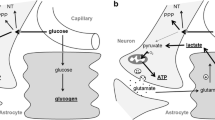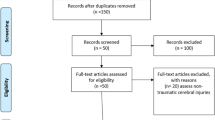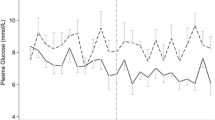Abstract
Glucose (Glue) is the main energy source for the brain. After severe head-injury energy demand is massively increased and supply is often decreased. In pilot microdialysis studies, many patients with severe head-injury had undetectable glucose concentrations, probably reflecting changes in metabolism and/or reduced supply. We therefore investigated whether patients with low ECF glucose (criterion: <50 µM for>5 hrs), LOWgluc, differ from patients with higher glucose levels (NORMALgluc) We also tested the interrelationships between other parameters such as lactate, glutamate, K+, brain O2 and CO2, ICP, CPP, and CBF in these two groups.
We found that patients with low ECF glucose, LOWgluc, have significantly lower lactate concentrations than patients with “normal” glucose, NORMALgluc, levels do. Spearman correlations between glucose and most other parameters were similar in both patient groups. However, glutamate correlated positively with glucose, lactate, brain CO2 and negatively with brain O2 in the NORMALgluc patient group, whereas glutamate did not significantly correlate with any of these parameters in the LOWgluc group. There was also no correlation between outcome and the dialysate glucose. The results indicate that low ECF glucose is almost always present in severe head-injury. Moreover, the lack of correlation between low glucose and outcome, however, suggests that other energy substrates, such as lactate, are important after TBI.
Access this chapter
Tax calculation will be finalised at checkout
Purchases are for personal use only
Preview
Unable to display preview. Download preview PDF.
Similar content being viewed by others
References
Alessandri B, Basciani R, Langemann H, Lyrer P, Pluess D, Landolt H, Gratzl O (1999) Chronic effects of an aminosteroid on microdialytically measured parameters after experimental middle cerebral artery occlusion in the rat. J Clini Neurosci (accepted for publication)
Alessandri B, Bullock R (1998) Glutamate and its receptors in the pathophysiology of brain and spinal cord injuries. In: Ottersen OP, Langmoen I, Gjerstad L (eds) Progress in brain research. Elsevier Science, Amsterdam, pp 301–311
Alessandri B, Doppenberg E, Woodward J, Bullock R (1997) Evidence for time-dependent glutamate-mediated glycolysis in head-injured patients: a microdialysis study. In: Bullock Rea (ed) Neurochemical monitoring, Satellite Symposium of the 10th International Symposium on Intracranial Pressure ..., vol. in press. Williamsburg, VA USA, pp PO-2–076
Alessandri B, Langemann H, Lutz TW, Basciani R, Fuhrer B, Lyrer P, Landolt H, Gratzl O (1999) Acute effects of an aminosteroid on microdialytically measured parameters after experimental middle cerebral artery occlusion in the rat. J Clini Neurosci 6 in press
Beck T, Goller HJ, Wree A (1995) Chronic depression of glucose metabolism in postischemic rat brains. Stroke 26: 1107–1113
Bergsneider M, Hovda DA, Shalmon E, Kelly DF, Vespa PM, Martin NA, Phelps ME, McArthur DL, Caron MJ, Kraus JF, Becker DP (1997) Cerebral hyperglycolysis following severe traumatic brain injury in humans: a positron emission tomography study. J Neurosurg 86: 241–251
Bouma GJ, Muizelaar JP (1995) Cerebral blood flow in severe clinical head injury. New horizons,http://www.biomednet.com/db/medline/96056618 3: 384–394
Bouma GJ, Muizelaar JP, Stringer WA, Choi SC, Fatouros P, Young HF (1992) Ultra-early evaluation of regional cerebral blood flow in severely head-injured patients using xenon-enhanced computerized tomography [see comments]. J Neurosurg http://www.biomednet.com/db/medline/9237329977: 360–368
Bullock R, Zauner A, Myseros JS, Marmarou A, Woodward JJ, Young HF (1995) Evidence for prolonged release of excitatory amino acids in severe human head trauma. Ann NY Acad Sci 765: 290–297
Bullock R, Zauner A, Tsuji O, Woodward J, Young H, Marmarou A (1994) Excitatory amino acid releases after severe head trauma: Effect of intracranial pressure and cerebral perfusion pressure changes. In: Nagai H, Kamiya K, Ishii S (eds) Ninth International Symposium on Intracranial Pressure. Nagoya, Japan, pp 264–267
Bullock R, Zauner A, Tsuji O, Woodward JJ, Marmarou AT, Young HF (1995) Patterns of excitatory amino acid release and ionic flux after severe human head trauma. In: Tsubokawa T, Marmarou AT, Robertson C, Teasdale G (eds) Neurochemical monitoring in the intensive care unit. Springer, Berlin Heidelberg New York, Tokyo, pp 64–71
Bullock R, Zauner A, Woodward J, Young HF (1995) Massive persistent release of excitatory amino acids following human occlusive stroke. Stroke 26: 2187–2189
Dietrich WD, Alonso O, Busto R (1993) Moderate hyperglycemia worsens acute blood-brain barrier injury after forebrain ischemia in rats. Stroke 24: 111–116
Doppenberg EMR, Zauner A, Bullock R, Woodward J, Young HF (1996) Evidence for glutamate-medicated anerobic glycolysis, after human head injury? A microdialysis study. J Neu-rotrauma 13: 597
Fray AE, Boutelle M, Fillenz M (1997) Extracellular glucose turnover in the striatum of unanaesthetized rats measured by quantitative microdialysis [In Process Citation], J Physiol (Lond)504: 721–726
Katayama Y, Becker DP, Tamura T, Hovda DA (1990) Massive increases in extracellular potassium and the indiscriminate release of glutamate following concussive brain injury. J Neurosurg 73: 889–900
Katayama Y, Kawamata T, Kano T, Tsubokawa T (1992) Excitatory amino acid antagonist adminstered via microdialysis attenuates lactate accumulation during cerebral ischemia and subsequent hippocampal damage. Brain Res 584: 329–333
Kawamata T, Katayama Y, Hovda DA, Yoshino A, Becker DP (1995) Lactate accumulation following concussive brain injury: the role of ionic fluxes induced by excitatory amino acids. Brain Res 674: 196–204
Langemann H, Mendelowitsch A, Landolt H, Alessandri B, Gratzl O (1995) Experimental and clinical monitoring of glucose by microdialysis. Clin Neurol Neurosurg 97: 149–155
Magistretti PJ, Pellerin L (1996) Cellular mechanisms of brain energy metabolism. Relevance to functional brain imaging and to neurodegenerative disorders. Ann NY Acad Sci 777: 380–387
Magistretti PJ, Pellerin L (1997) Metabolic coupling during activation. A cellular view. Adv Exp Med Biol 413: 161–166
Magistretti PJ, Sorg O, Naichen Y, Pellerin L, de Rham S, Martin JL (1994) Regulation of astrocyte energy metabolism by neurotransmitters. Ren Physiol Biochem 17: 168–171
McCall AL, Van BAM, Nipper V, Moholt Siebert M, Downes H, Lessov N (1996) Forebrain ischemia increases GLUT1 protein in brain microvessels and parenchyma. J Cereb Blood Flow Metab 16: 69–76
Pellerin L, Magistretti PJ (1994) Glutamate uptake into astrocytes stimulates aerobic glycolysis: a mechanism coupling neuronal activity to glucose utilization. Proc Natl Acad Sci USA 91: 10625–10629
Pellerin L, Magistretti PJ (1996) Excitatory amino acids stimulate aerobic glycolysis in astrocytes via an activation of the Na+/K+ ATPase. Dev Neurosci 18: 336–342
Persson L, Valtysson J, Enblad P, Warme PE, Cesarini K, Lewen A, Hillered L (1996) Neurochemical monitoring using intracerebral microdialysis in patients with subarachnoid hemorrhage. J Neurosurg 84: 606–616
Qian Y-Z, Di X, Chen T, Bullock R (1998) Lactate/glucose dynamics after rat fluid percussion injury. J Neurotrauma 15: 903
Schurr A, Payne RS, Miller JJ, Rigor BM (1997) Brain lactate, not glucose, fuels the recovery of synaptic function from hypoxia upon reoxygenation: an in vitro study. Brain Res 744: 105–111
Sutton RL, Hovda DA, Adelson PD, Benzel EC, Becker DP (1994) Metabolic changes following cortical contusion: relationships to edema and morphological changes. Acta Neurochir [Suppl] (Wien) 60:446–448
Valadka AB, Goodman JC, Gopinath SP, Uzura M, Robertson CS (1998) Comparison of brain tissue oxygen tension to micro-dialysis-based measures of cerebral ischemia in fatally head-injured humans. J Neurotrauma, http://www.biomednet.com/db/medline/98337311 15: 509–519
Vannucci SJ, Seaman LB, Vannucci RC (1996) Effects ofhypo-xia-ischemia on GLUT1 and GLUT3 glucose transporters in immature rat brain. J Cereb Blood Flow Metab 16: 77–81
Yamaki T, Imahori Y, Ohmori Y, Yoshino E, Hohri T, Ebisu T, Ueda S (1996) Cerebral hemodynamics and metabolism of severe diffuse brain injury measured by PET [see comments]. J Nucl Med 37: 1116–1170
Yamaki T, Yoshino E, Fujimoto M, Ohmori Y, Imahori Y, Ueda S (1996) Chronological positron emission tomographic study of severe diffuse brain injury in the chronic stage. J Trauma 40: 50–56
Yao H, Ginsberg MD, Eveleth DD, LaManna JC, Watson BD, Alonso OF, Loor JY, Foreman JH, Busto R (1995) Local cerebral glucose utilization and cytoskeletal proteolysis as indices of evolving focal ischemic injury in core and penumbra. J Cereb Blood Flow Metab 15: 398–408
Zauner A, Bullock R, Kuta AJ, Woodward J, Young HF (1996) Glutamate release and cerebral blood flow after severe human head injury. Acta Neurochir [Suppl] (Wien) 67: 40–44
Zauner A, Doppenberg E, Woodward JJ, Allen C, Jebraili S, Young HF, Bullock R (1997) Multiparametric continuous monitoring of brain metabolism and substrate delivery in neurosurgical patients. Neurol Res 19: 265–273
Author information
Authors and Affiliations
Editor information
Editors and Affiliations
Rights and permissions
Copyright information
© 2000 Springer-Verlag Wien
About this paper
Cite this paper
Alessandri, B., Reinert, M., Young, H.F., Bullock, R. (2000). Low Extracellular (ECF) Glucose Affects the Neurochemical Profile in Severe Head-Injured Patients. In: Mendelow, A.D., et al. Brain Edema XI. Acta Neurochirurgica Supplements, vol 76. Springer, Vienna. https://doi.org/10.1007/978-3-7091-6346-7_88
Download citation
DOI: https://doi.org/10.1007/978-3-7091-6346-7_88
Publisher Name: Springer, Vienna
Print ISBN: 978-3-7091-7257-5
Online ISBN: 978-3-7091-6346-7
eBook Packages: Springer Book Archive




